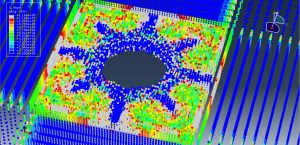In this tutorial, finite element analysis of smooth particle hydrodynamics for application to projectile impact on cementitious material has been investigated. The performance of brittle, cementitious armor panels under high-rate impact is dependent on a wide range of variables including but not limited to projectile and target geometry, impact velocity, type of projectile material, and angle of impact of the projectile. Due to comparatively low cost,
ease of rapid on-site manufacture, and high early strength, the use of HSC material as protective armor has been an attractive option for passive protection from weapon effects. Understanding the performance of such armor pan-els under high-rate ballistic impact is vital to ensure the safety of personnel in forwarding combat environments. Accurate simulation of the structural response of armor panels to such dynamic loads is a convenient way to significantly decrease the cost of R&Defforts related to new materials and applications. The projectile and concrete panel are modeled as a three-dimensional solid part. You can see a figure of the assembled part at below
The steel material as elastic property with Johnson-Cook plasticity and damage criterion is used to model projectile behavior. The concrete material model in Abaqus separated to some models like CDP, Brittle cracking,….Among these material models, the Johnson-Holmquist model has a better performance and it can be used through the VUMAT subroutine or input file. The dynamic explicit step is appropriate for this type of analysis. The general contact algorithm is used with contact property as a friction coefficient. The fixed boundary condition is used for the concrete panel and the initial velocity for the projectile. The SPH formulation is used for the concrete panel and the mesh should be so fine at the contact zone
During the simulation, the projectile penetrated into the concrete and at that zone, huge damage is created. All outputs such as damage variable, stress, strain, failure…can be available. You can see some figures for the result below








You can provide CAE ,INP,and English video files of this simulation here. The cost of these files is Twenty-Eight Euros. you can click on the bellow bottom to beginning process
You can purchase the tutorial through a PayPal account, a Visa, or a Master card, just before payment,send me an email to this address: karampourp@gmail.com
 Abaqus tutorials Abaqus tutorials
Abaqus tutorials Abaqus tutorials




